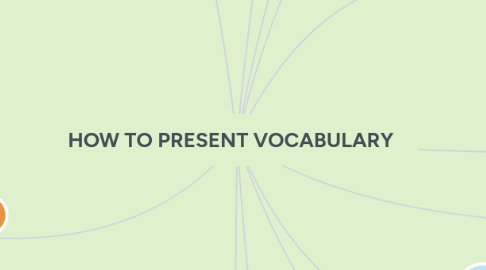
1. How to explain vocabulary
1.1. real objects, illustration, or demostration, is limited
1.1.1. word frequently come up incidentally
1.1.1.1. An alternative way of conveying the meaning of a word is use other words
1.2. Situational method
1.2.1. Provide a scenario which clearly contextualises the target word
1.2.1.1. Provide students example sentences
1.2.2. Induction
1.2.2.1. the mental process of hypothesising from examples
1.3. Glossing
1.3.1. explaining words that come up in texts
1.4. Definition
1.4.1. teacher and learner require more informaton
2. How to highlight the form
2.1. drawing learners´ attention to the way the word sounds
2.2. Ways of highlighting the spoken form of the word.
2.2.1. Listening drills
2.2.2. Oral drills
2.2.3. Boardwork
2.2.4. A drill is any repetition of a short chunk language
2.3. Subvocalisation
2.3.1. is a technique that successful learners use naturally
2.4. Phonemic script
2.4.1. is the written form of a word
3. How to envolve the learners
3.1. Elicitation
3.1.1. It is for the teacher to present the meaning of a word
3.1.2. asking learners to supply the form
3.1.3. The rational underlaying elicitation is that:
3.1.3.1. it actively involves
3.1.3.2. it speaking opportunities
3.1.3.3. it keep alert and attention
3.1.3.4. it challenges better learners
3.1.3.5. It checks student understanding
3.1.3.6. it encourages learners to use contextual clues
3.2. Personalisation
3.2.1. It is the process of using the new word in a context that is real for the learner personally.
3.3. Peer-teaching
3.3.1. Learner teach to another vocabulary
3.3.1.1. information gap: between students in order to complete a task and they must exchange information
4. The number of new words should not be overstretch
5. Pre-selected vocabulary
6. Incidental vocabulary
7. Learn meaning and form
7.1. must exist a gap between the presentation of these aspects
8. Aspects to know how many words present
8.1. The level of the learner
8.2. The learners likely familiarity with the words
8.3. The difficulty of the items
8.4. Their "teachability"
8.5. Whether items are being learned for production
9. Suggestopedia method
9.1. Techniques of relaxation and suggestion
9.1.1. hundred of words in a session
9.1.2. Input
10. Vocabulary presentation sequence
10.1. Meaning first, then form
10.2. Form first, then meaning
11. Using traslation
11.1. This has the advantage of being the most direct route to a word´s meaning
12. How to ilustrate meaning
12.1. Present a set of concrete objects
12.1.1. realia or pictures and mimic
12.2. Direct Method
12.2.1. traslation is not an option
12.3. Total Physical Response (TPR) method
12.3.1. Promotes initial immersion in a high quantity of comprehensible input
